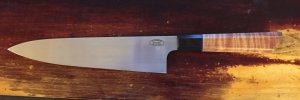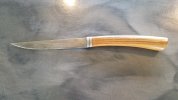Hmm, I'm not an authoritative source for an answer, but I have used white oak quite a bit. It has a larger grain than one might want, but you can seal it up with Tru-oil, load it full of boiled linseed oil, or just wax the snot out of it periodically. It sands quite smooth at 400-600. Quartersawn oak, particularly with knots and crotch sections can be quite beautiful. It's very tough stuff, doesn't dent or break easily. Hickory is tougher, but very boring. I've used both kiln-dried lumber scraps and naturally dried firewood pieces both from in-state delivery and from cleaning up my mom's yard with 100yo+ oaks. It does shink a bit after shaping. Usually I shape and finish, and then a month or two later go back and hit it with 400x again to knock down proud pins or micarta/G10 joints. Mostly I use white oak on my own blades, not for customers, with one notable exception. And oak has a nice sort of tannic vanilla bourbon-barrel smell when you grind it.

I find cherry and maple both dent or check far more than oak, and are probably best stabilized.
If you're willing to go as far south for wood as you are for lunch, Mexican katalox is a nice option for a dramatically dark wood. The figure is a subtle black/brown contrast, but it's there and sometimes curly. I've done 3 or 4 pieces in natural katalox, and it's burly stuff.
But in any case, I'd recommend micarta or G10 (ideally) bolsters for hidden tang knives, sealed with a good epoxy to prevent water intrusion. It's the front of the handle that takes the most beating.
This isn't a kitchen knife, but it sure was a ragged oak scrap that turned out nice. This was an iffy piece of wood, but I filled the little gaps with superglue, and they sanded out smooth:
And a small deba:
And a pair in katalox:







